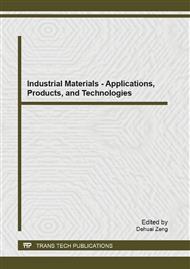[1]
Stephen M. Hsu: Nanolubrication: Concept and Design, in Nanotribology Critical Assessment and Research Needs, Springer, New Delhi (2006), pp.327-346.
Google Scholar
[2]
D. Dowson and G.R. Higginson: Numerical Solution to Elastohydrodynamic Problem, J. Mech. Eng. Sci., vol. 1 (1959), pp.6-15.
Google Scholar
[3]
R. Lee and B. J. Hamrock: Squeeze and Entraining Motion in Non-conformal Line Contacts Part II: Elastohydrodynamic Lubrication, ASME J. Tribol., vol. 111 (1989), pp.8-16.
DOI: 10.1115/1.3261968
Google Scholar
[4]
Jaw-Ren Lin: Squeeze film characteristics of finite journal bearings: couple stress fluid model, Tribology International, Vol. 31 (1998), p.201–207.
DOI: 10.1016/s0301-679x(98)00022-x
Google Scholar
[5]
M. Mongkolwongrojn, C. Aiumpornsin and K. Thammakosol: Theoretical Investigation in Thermoelastohydrodynamic Lubrication With Non-Newtonian Lubricants Under Sudden Load Change, Journal of Tribology, vol. 128 (2006), p.771–777.
DOI: 10.1115/1.2345393
Google Scholar
[6]
W. Habchi and et al.: Influence of pressure and temperature dependence of thermal properties of a lubricant on the behaviour of circular TEHD contacts, Tribology International, Vol. 43 (2010), p.1842–1850.
DOI: 10.1016/j.triboint.2009.10.002
Google Scholar
[7]
Roelands, C.J.A.: Correlational Aspects of the Viscosity-Temperature-Pressure Rela-tionship of Lubricating Oils, Druk, V.R.B., Groingen, Netherland (1969).
Google Scholar
[8]
H.G. Rylander : A Theory of Liquid-Solid Hydrodynamic Film Lubrication, ASLE Journal of the American Society of Lubrication Engineering (1966), pp.264-271.
DOI: 10.1080/05698196608972143
Google Scholar
[9]
M. Chandrasekar, S. Suresh and A. Chandra Bose: Experimental investigations and theoretical determination of thermal conductivity and viscosity of Al2O3/Water nanofluid, Experimental Thermal and Fluid Science, Vol. 34 (2010), pp.210-216.
DOI: 10.1016/j.expthermflusci.2009.10.022
Google Scholar
[10]
D. Dowson and G.R. Higginson: Elastohydrody-namic Lubrication: The Fundamental of Roller and Gear Lubrication, Pergamon, Oxford (1966).
Google Scholar
[11]
Hua, D. Y. and Khonsari, M. M.: Elastohydrodynamic Lubrication by Powder Slurries, ASME J. Tribology, Vol. 118 (1996), pp.67-73.
DOI: 10.1115/1.2837094
Google Scholar
[12]
M. Javadi and M. Tajdari: Experiment investigation of the friction coefficient between aluminium and steel, Materials Science-Poland, Vol. 24 (2006), pp.305-310.
Google Scholar


